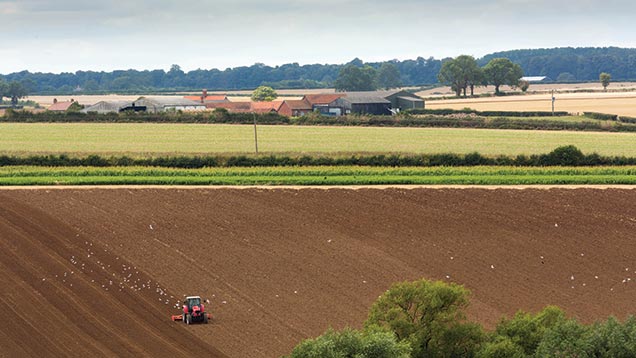Advice on managing cashflow challenge on arable farms
 ©Tim Scrivener
©Tim Scrivener Arable farmers need to lock down on spending to deal with the 18-month cash challenge faced by many, says consultant Brown & Co.
“The cash position is set to tighten considerably, especially on farms with rent to pay,” said Philip Dunn, head of agri-business consultancy.
The position is illustrated by the company’s Browns Farm model, a progressive eastern counties unit growing combinable crops and sugar beet on 386ha of arable land, 160ha of which is rented.
BPS receipt is budgeted for May as a worst case scenario.
See also: Farmers must act quickly to reduce 31 January tax bills
The farm risks breaching its £400,000 overdraft limit this spring with a further £100,000 requirement towards the end of the 2016-17 financial year. Net farm income for 2016-17, including BPS, will be about £15,000 in the red.
However, this is before accounting for private drawings, typically about £52,000 for this business. These cover personal spending, school fees, pension contributions and tax, while a further £26,000 in other bank drawings would fall due to cover capital items, mainly machinery purchases and financing.
The firm’s advice, which may apply on other farm types too, includes:
- Private drawings – review these and understand just how much your lifestyle costs
- Pension contributions – changes could be made as a short-term measure – but watch out for penalties
- Finance – the obvious solution at Browns Farm is to negotiate a higher overdraft. However, recent increases in working capital requirements could make this tricky.
Another option would be to consider putting the overdraft core (£300,000) on a long-term loan. This could be fixed at about 4% for 25 years, depending on existing gearing. This is probably slightly higher than the overdraft rate, but reduces risk. Sources such as trade credit could also be considered.
It may also be possible to negotiate better rent terms, such as quarterly payment in arrears rather than half-yearly in advance. However there is little prospect of a reduction at the September 2016 review (current rent £200/acre). Serving notice to quit is not considered a good option as the business is geared to farm almost 400ha.
Other options include taking on land through contracting, which could be considered if there is labour and machinery scope.
“The other alternative is to put the whole farm in a contract farming agreement, allowing the business to liquidate some assets while maintaining its trading status,” said Mr Dunn. However, such a wholesale move needed to be well planned to include succession and longer-term aims of the family.
Other short-term options
- Look harder at enterprise mix, input purchasing, sales and marketing
- Consider new Countryside Stewardship scheme and taking land out of production
- Is there surplus machinery to sell? The business could, for example, sell the combine and enter into joint venture, paying annual charge. Understandably people want control over their own harvest but this is worth some considering – other items might follow
- Could a tractor be hired rather than owned? This is not easy in all situations because of work windows
- Investigate flexi-loans such as those offered by AMC – a five-year product offering pre-agreed funding farmers can access if required
- Consider tax averaging to avoid tax hits from previously profitable years
- Look at assets – what is being underused or would not be missed?
- Consider selling off-lying land parcels whose sale will have little of no effect on the bottom line. High-value small areas for garden extensions are ideal and can earn a significant premium without a big effect
- Selling cottages is not an option at Browns Farm, but other businesses might consider this, especially if properties are empty or bring low/no rent
- Permitted development – Class Q allows change of use from agricultural building to commercial/residential, which means a property could be on the market within weeks.
Medium/longer-term fixes
- New enterprises – Browns Farm has £1m borrowed on £5m of assets, so there is potential to borrow more against these assets to start a new enterprise – for example pig finishing (bed-and-breakfast accommodation) or poultry buildings for a third-party operator. Money is available at about 4% for a 30-year loan too
- Consider letting areas of land for alternative enterprises – for example pigs, poultry or potatoes. Do a partial budget and consider the agronomic as well as the financial implications
- Consider a change in cultivation strategy to reduce overall horsepower requirement
- Renewables – wind and solar still have potential, but require investment. An agreement with another party may make this more viable
- Consider opportunities under Strategic Housing Land Availability Assessment (SHLAA). Many councils are not meeting their housing targets – talk to your local council to see if land might be suitable for housing, even if outside the development envelope.
- Battery barns: Energy companies are looking for sites to store energy, so this could provide useful income and a barn at the end of the contract.
